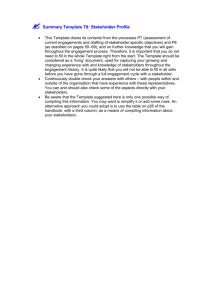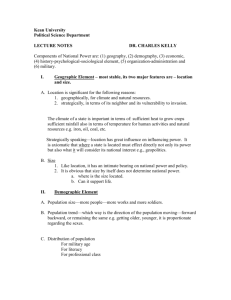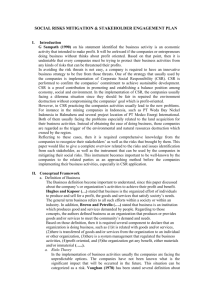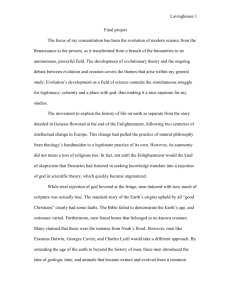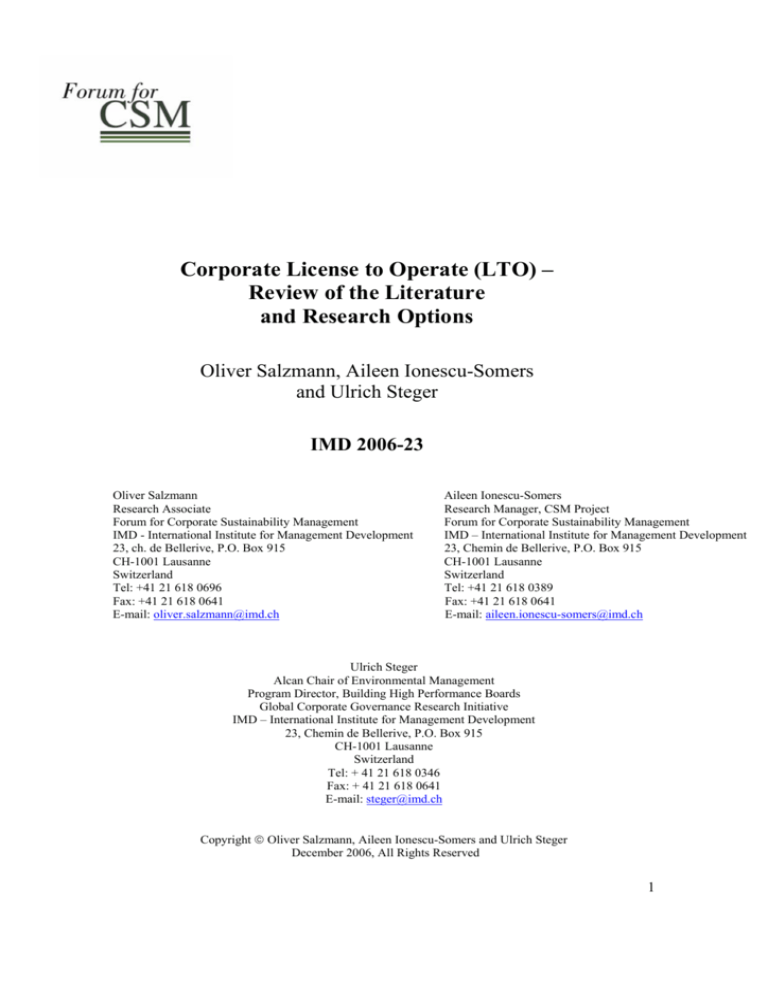
Corporate License to Operate (LTO) –
Review of the Literature
and Research Options
Oliver Salzmann, Aileen Ionescu-Somers
and Ulrich Steger
IMD 2006-23
Oliver Salzmann
Research Associate
Forum for Corporate Sustainability Management
IMD - International Institute for Management Development
23, ch. de Bellerive, P.O. Box 915
CH-1001 Lausanne
Switzerland
Tel: +41 21 618 0696
Fax: +41 21 618 0641
E-mail: oliver.salzmann@imd.ch
Aileen Ionescu-Somers
Research Manager, CSM Project
Forum for Corporate Sustainability Management
IMD – International Institute for Management Development
23, Chemin de Bellerive, P.O. Box 915
CH-1001 Lausanne
Switzerland
Tel: +41 21 618 0389
Fax: +41 21 618 0641
E-mail: aileen.ionescu-somers@imd.ch
Ulrich Steger
Alcan Chair of Environmental Management
Program Director, Building High Performance Boards
Global Corporate Governance Research Initiative
IMD – International Institute for Management Development
23, Chemin de Bellerive, P.O. Box 915
CH-1001 Lausanne
Switzerland
Tel: + 41 21 618 0346
Fax: + 41 21 618 0641
E-mail: steger@imd.ch
Copyright © Oliver Salzmann, Aileen Ionescu-Somers and Ulrich Steger
December 2006, All Rights Reserved
1
Corporate License to Operate (LTO) – Review of the Literature
and Research Options
Oliver Salzmann
Aileen Ionescu-Somers
Ulrich Steger
Background and objective
While it is true that the main objective of private corporations is to generate returns for
shareholders, companies are nevertheless institutions within society and thus cannot be
defined by economic performance alone but also by their political, social/societal and
environmental role. However, various empirical studies (Salzmann, 2005; Steger, 2004)
have also shown that shareholders’, customers’ and regulators’ interests are partly
conflicting and exert little external pressure on companies to resolve or mitigate social
and environmental issues associated with their primary and secondary activities. Hence,
can one seriously claim that CSM improves companies’ license to operate, that it
compensates for corporate risks associated with the neoclassical approach to doing
business, which has become increasingly dominant in a period of globalization and
deregulation? To allow for a sound research effort to answer these questions, the authors
of this paper aim to
examine related theoretical framework and concepts, and
assess empirical studies conducted in this domain, in order to
propose a meaningful research objective and an appropriate research
methodology.
Theoretical frameworks
Obviously the notion of the “license to operate” is strongly linked to several other
concepts such as legitimacy, reputation, stakeholders and corporate social
responsibility/performance. Furthermore, various theoretical frameworks exist in this
domain, such as
political economy theory (focusing on the interconnectedness between political,
social and economic influences)
stakeholder theory (based on the direct effect that stakeholders have on a
corporation’s activities)
accountability theory (based on the right of the principal stakeholder to require
information) and
legitimacy theory derived from the concept of organizational legitimacy
(Freeman, 1984; Suchman, 1995).
In the following section, the authors will focus on legitimacy theory, stakeholder theory
and corporate social performance models as the key frameworks in this area.
2
Legitimacy theory
Suchman (1995, p. 574) defined legitimacy as a “generalized perception or assumption
that the actions of an entity are desirable, or appropriate within some socially constructed
system of norms, values beliefs and definitions.” Companies need to conserve legitimacy
to survive. They manage their legitimacy by (1) conforming to societal expectations, (2)
selecting supportive stakeholders, and (3) creating new ideas of what is legitimate
behavior. In this respect, legitimacy is one of several motivating principles of corporate
social performance (Wood, 1991).
However, a correct perception of what society “desires” is difficult: Legitimacy
management is complex because of the great number of highly fragmented issues and
stakeholders (Steger, 2004; Suchman, 1995). This fact is also reflected in the two
different strands of theory (Suchman, 1995):
Strategic legitimacy theory suggests that legitimacy is to a certain extent
controllable by managers. It is seen as a resource that organizations want to obtain
through corporate activities such as communication (even if reduced to the
manipulation of symbols), social and environmental initiatives, etc. (Ashforth &
Gibbs, 1990; Dowling & Pfeffer, 1975).
Institutional legitimacy theory sees legitimacy as a constraint and focuses on the
cultural environment in which organizations (rather than firms as such) exist and
on the normative pressure that this environment exerts on them (Massey, 2001).
The potential for building corporate reputation (excellence) or legitimacy (acceptability)
depends on the divergence and the dialectics between the two trajectories of issuespecific corporate performance and societal expectations (Zyglidopoulos, 2003). The
research effort referred to above takes account of both perspectives.
Stakeholder theory
Various scholars have contributed to the development of stakeholder theory over the last
decades (Freeman, 1984; Jones & Wicks, 1999, Donaldson, 1995). The framework is,
like strategic legitimacy theory, focused on managerial decision-making and based on
several complementary premises including the following (Jones et al., 1999, p. 207):
1. Corporations have relationships with many constituent groups that affect and are
affected by its decisions (Freeman, 1984).
2. These relationships affect corporate processes and outcomes.
3. The interests of all (legitimate) stakeholders have intrinsic value, and no set of
interests is assumed to dominate the others (Clarkson, 1995; Donaldson &
Preston, 1995).
Jones and Wicks (1999) differentiated between three types of stakeholder theory:
normative, instrumental and empirical/descriptive. The research objective described
above obviously aligns with the instrumental strand, which suggests that certain
outcomes – such as changes in companies’ license to operate – are more likely if
managers/companies behave in a certain way (p. 207). Instrumental theory is obviously
3
contingent theory (Jones et al., 1999, p. 208): The predicted outcome is contingent on
behavior of a certain type, i.e. firms that develop trust-based, cooperative ties with their
stakeholders could gain a competitive advantage over firms that do not (Donaldson et al.,
1995; Freeman, 1984; Jones, 1995).
Stakeholder theory in the context of corporate social performance primarily reflects an
antinomy between social and financial performance. In this context Margolis and Walsh
(2004) argue for a reorientation of theory and thus empirical research. They also take an
instrumental-descriptive stance by (1) stating that “organizations can play an effective
role in ameliorating social misery,” and (2) calling for a focus on corporate social
activities and their effects on both firms and society (pp. 283).
Corporate social performance
Literature on corporate social responsibility and corporate social performance has
extensively discussed the importance of stakeholders and legitimacy of companies (Sethi,
1975; Swanson, 1999; Wartick & Cochran, 1985; Wood, 1991; Wood, 1991a). Three
models of corporate social performance will be briefly elaborated on in the following, as
they are among the most recent and stringent frameworks available today.
In Wood’s (1991) model, the motivating principle of legitimacy is based on Davis’s law
of responsibility (Davis, 1973, p. 314). This law suggests that power and responsibility
are co-equal: Avoidance of social responsibility leads to a reduction in power, since other
societal groups – most importantly governments – will assume the necessary
responsibilities.
Husted (2000) depicts an issue-contingent model of corporate social performance, based
on which certain issues management strategies and structures lead to greater social
performance, defined as the level of stakeholders’ satisfaction with corporate activities.
Based on their empirical study, Greening and Gray (1994) developed a model that
features corporate resources, institutional pressure and managerial discretion as key
determinants of corporate social performance.
Key concepts
In the following sections the authors will define the key concepts of the license to operate
and corporate sustainability management (CSM) in more detail.
License to operate
So far there are no academic definitions of the notion of the license to operate (LTO).
Because of its relation to similar concepts such as legitimacy and reputation it is
particularly important to depict its meaning clearly. In the present study, the license to
operate is defined as
the degree of match between stakeholders’ individual expectations of corporate behavior and
companies’ actual behavior.
4
Obviously stakeholders’ expectations are subject to several contingencies, such as the
type and visibility of the issue under consideration and the company’s visibility, societal
standards and values. Hence they vary across different locations (Bowen, 2000;
Salzmann, 2005; Steger, 2003).
Since stakeholders can differ across all these determinants, their expectations or demand
for CSM vary. Furthermore the power to amend or revoke companies’ license to operate
is specific to the individual stakeholder and society, e.g. global NGOs’ campaigns against
global companies’ activities in developing countries may [more than] make up for the
lack of both legislation and enforcement one tends to find there.
In this context it is meaningful to differentiate between two kinds of LTO: the formal and
the informal. Obviously regulators determine the formal LTO, non-regulatory
stakeholders the informal.
The bargaining power of regulatory and non-regulatory stakeholders has different
determinants:
Determinants of the formal LTO
Determinants of the informal LTO
-
Geographical location of key social or
environmental intake
-
Geographical location of key social or
environmental intake less important
-
Location of key social or environmental intake
within the value chain
-
Location of key social or environmental intake
within the value chain less important
-
Certainty and the transparency of the issue
-
Certainty and the transparency of the issue less
important
-
Overall bargaining power of governments as
suppliers (primarily relevant to extractive
industries)
-
Vulnerability of reputation, brands and profit,
particularly in the short term
Table 1: Determinants of the license to operate – based on Salzmann (2005, p. 132)
There are several reasons why the informal LTO appears to be a more compelling
research subject:
1. Unlike the formal LTO, upon which all companies rely unless they are willing to take
the risk of non-compliance, the informal LTO is not a given. It is associated with a
financial premium, since it can be revoked or amended more swiftly than the formal
LTO (Steger, 2003, p. 73).
2. Globalization and liberalization tend to decrease regulators’ power, and this tends to
be compensated for by civil society’s increasing scrutiny of corporate activities.
3. This external pressure from civil society may in some instances lead to changes in
regulations, i.e. the formal LTO. The informal LTO may be a lead indicator for the
formal one.
5
Corporate sustainability management
To date, only a few scholars have referred to the notion of CSM. This is primarily
because related terminologies and frameworks for concepts such corporate social
responsibility and corporate social performance are better developed. However, even the
most comprehensive frameworks from Wood (1991), Greening and Gray (1994), and
Husted (2000) are less suitable for research into the LTO.
Functional relationships between possible key concepts
Corporate sustainability management
Implementation
Management tools (policies, standards)
and structures
Strategic
disposition
Initiatives to improve
corporate social and environmental effects
Outcome
External communication activities, e.g. stakeholder
dialogue, donations, PR/lobbying etc.
Match or mismatch lead to changes in LTO, i.e. changes in the level
of the individual stakeholders’ satisfaction with the company
Stakeholders’
expectations
Figure 1: Framework and key concepts
In the authors’ proposed model of corporate sustainability performance, companies’ LTO
is determined by the extent to which (1) their strategic disposition to CSM, (2) their
approach to its implementation, and (3) the resulting social and environmental effects
(outcome) match stakeholders’ expectations (see Figure 1).
In this context CSM – like any strategic profit-driven approach to resolve or mitigate
environmental and social issues (Salzmann, 2005, p. 23) – should be clearly distinguished
from the notion of short-term PR-oriented crisis management (often referred to as issues
management).
The framework also takes into account the different facets of CSM implementation that
may influence companies’ LTO, including management tools and structures, corporate
social and environmental initiatives, and communication activities. Hence it is fairly
broad and may require some focus on one or two key concepts.
6
Review of empirical studies
Polls
Several different polls have examined stakeholder perceptions of various topics. But their
importance is limited, since they are unable to capture the effects of CSM on the LTO
beyond the typical conclusion on changes in the willingness to act, which is hardly
reflected in changes in behavior (attitude-behavior gap). Hence, in the following the
authors only present the results of a few representative examples:
-
Millennium Poll interviews with over 25,000 average citizens across 23 countries on
6 continents revealed that two in three citizens want companies to go beyond their
traditional profit-making role and contribute to broader societal goals as well. Over
one in five consumers report either rewarding or punishing companies in the past year
– based on their perceptions of corporate social performance – by avoiding the
company’s products or speaking against the company to others (Environics
International, 1999).
-
A survey carried out by MORI indicated that the share of consumers who consider
aspects of corporate social responsibility when making purchasing decisions is
actually declining.1 MORI attributed the decline in consumers’ stated importance of
social responsibility in purchasing decisions to a more challenging economic climate
since 9/11 and the various scandals such as Enron and WorldCom. Furthermore,
MORI found that a company’s record on social and environmental issues would be
the deciding factor for only 12% of people if two products were equal on price and
quality (MORI, 2002).
-
Furthermore, surveys on the chemical industry suggest that initiatives such as the
Responsible Care Program managed to stop the continuous decline in corporate
reputations that occurred over the 1990s and even managed to improve them relative
to eight other benchmarked industries (CEFIC, 2000; Tandy, 2000).
Academic studies
In contrast to the polls elaborated on above, academic studies have clearly focused on
company data and managers’ perceptions of corporate social responsibility as well as the
legitimacy and effect of stakeholders’ demands. Since this approach is clearly less
relevant to this paper, the authors only briefly list some these studies below:
1
In 2003, 38% of British consumers regarded corporate social responsibility as very important when
making purchases. This result has declined somewhat since 2001, when the percentage was 46% Maitland,
A. 2003. An ethical answer to consumers’ fears, Financial Times: 11.
7
Source
Methodology/finding
LTO as a driver
Langton & Lewin (1982)
Showed that the business community was held in low esteem despite
public interest advertising; concluded that companies needed to instigate
adaptive mechanisms to achieve ongoing validation and legitimacy.
Henriques & Sadorsky (1995)
Quantitative study on North American companies and their drivers for
environmental responsiveness (operationalized as the existence of an
environmental plan/policy in the company): They found legitimacy
(external pressure) to be a significant driver.
Bansal & Roth (2000)
Qualitative study on two large UK firms: They identified the potential to
improve long-term profitability (competitiveness) from improved
reputation as one of several motivations for ecological responsiveness.
Bansal & Clelland (2004)
Analysis of media reports and stock prices of 100 firms over a 5-year
period: Found moderate support for the hypothesis that firms that
voluntarily disclose environmental liabilities will experience higher
unsystemic risk; conclusions: Managers of firms with low
environmental legitimacy may be advised to
- manage their firms’ environmental performance and thus minimize
negative media reports
- disclose environmental liabilities, or
- invest in impression management efforts that illustrate corporate
commitment to the natural environment, or
- launch some low-cost environmental initiatives.
Analysis of social disclosure data from 1975 to 1997 in five companies
representing three FTSE sectors: Concluded that legitimacy theory may
be an explanation for disclosure in some cases but not in others.
Campbell (2003)
Effects of an improved LTO (e.g. through stakeholder management, communication, crisis management)
Inter alia Berman (1999),
Ogden (1999)
Directly tested the hypothesis that corporations whose managers adopt
stakeholder approaches will show better financial performance than
those whose managers do not, to some extent, presumably, due to
increased license to operate Î refer to individual studies for detailed
conclusions.
Heugens (2002)
Study on the introduction of genetically modified food products in the
Netherlands; conclusions: Stakeholder integration, through the
development of mutually enforcing relationships with external parties,
may result in both organizational learning and societal legitimacy.
Massey (2001)
Based on empirical data, Massey concluded that companies providing
consistent crisis response across stakeholders enhance their corporate
legitimacy compared with other companies that employ less consistent
practices.
Figure 2: Empirical studies
Only a few studies examined the stakeholders’ perception and expectation of CSM. Their
findings tend to align with findings from Steger (2004), Salzmann (2005) and IonescuSomers (forthcoming). Based on the qualitative and quantitative data collected, these
authors concluded that:
1. The majority of stakeholders are largely ignorant about CSM, i.e. improvements
in companies’ LTO due to CSM are likely to be marginal. “Real” changes in LTO
8
(when factoring out social desirability bias) will be small and thus hard to
measure.
2. Stakeholders’ interest and expectations are highly fragmented, contradictory and
primarily issue-specific.
Research objective and focus
The research area described exhibits – because of the contingent nature of the LTO – a
substantial number of degrees of freedom. To generate meaningful data that may allow
findings beyond the typical “poll,” a focus on certain sectors/companies, issue
dimensions (environmental or social issues) or even individual issues as well as certain
stakeholders is imperative. Significant moderating factors such as organizational
visibility should be taken into account.
Issues
CSM
• Strategic disposition
• Implementation
• Outcome
Stakeholders
Expectations
Climate change
GMOs
……
Human rights
Moderating factors
• Organizational size
• Consumer brand recognition
• Organizational “history”
•…
Corporate
activities perceived
as insufficient from
stakeholder
perspective
Î Punishment?
Corporate
activities perceived
as sufficient from
stakeholder
perspective
Î Reward?
• Shareholders
• Citizen’s
initiatives
• Global NGOs
• Consumers
• Corporate
customers
• Regulators
• Legislators
• Industry
associations
• Managers
• Rating agencies
• ….
Hypothesis: Sustainability leaders are less likely to be punished and more likely to be rewarded
Figure 3: Scope of possible research areas
Furthermore, the authors make some recommendations on plausible research foci:
Key concept
Focus recommended
Reasons
CSM
-
-
Implementation, more specifically corporate
activities related to key social and
environmental issues.
Strategies are not equally
swiftly implemented by
companies. Activities “on
the ground” are a more
9
-
Complemented by communication activities
that are likely to moderate the effects of
actual social and environmental initiatives
on LTO
Issues
-
Focus on the one to three most important
social or environmental issues that sector is
currently facing.
-
Ensure that only relevant
issues are discussed.
Stakeholders
-
Focus on four or five key stakeholders,
possibly some of the following:
-
In many instances, several
interviews per stakeholder
may be necessary since
interviewees in NGOs and
authorities in particular may
be familiar/concerned only
with a certain issue.
-
It could also be most
interesting to juxtapose
mainstream and niche
views, e.g. why do certain
shareholders support
environmental or social
shareholder resolutions,
why does the mainstream
ignore them?
-
It is most interesting to find
common factors that
influence effects on LTO.
Moderating factors
-
o
NGOs
o
Authorities (e.g.
national/transnational
regulator/legislator)
o
Customers
(consumers/corporate
customer)
o
Shareholders/creditors
o
Communities
o
Unions
o
Employees
No focus recommended, “open search”
required
reliable measure of the level
of CSM.
Figure 4: Recommendations for research focus
We also make the following suggestions about a research rationale that should allow for
compelling research results insofar as findings should go beyond those of polls and
academic studies conducted so far:
-
Focus on future developments rather than the present (on which most polls focus).
This focus is most likely associated with an even greater social desirability bias than
examining perceptions of the present.
-
A comparison of different stakeholders’ perceptions.
-
A “devil’s advocate” position: Previous empirical findings from the business case for
sustainability research suggest that a dominant proportion of stakeholders are ignorant
about CSM. A study that ruthlessly uncovers this ignorance and its causes would
draw more attention than reporting on the typical percentage increase of e.g. SRI
product market share.
10
Bibliography
Ashforth, B. E. & Gibbs, B. W. 1990. The double-edge of organizational legitimation.
Organization Science, 1: 177-194.
Bansal, P. & Roth, K. 2000. Why companies go green: A model of ecological
responsiveness. Academy of Management Journal, 42: 717-736.
Bansal, P. & Clelland, I. 2004. Talking trash: Legitimacy, impression management, and
unsystematic risk in the context of the natural environment. Academy of Management
Journal, 47(1): 93 -.
Berman, S., Wicks, A. C., Kotha, S., & M, J. T. 1999. Does stakeholder orientation
matter? The relationship between stakeholder management models and firm financial
performance. Academy of Management Journal, 43(5): 488-504.
Bowen, F. E. 2000. Environmental visibility: A trigger of green organizational response?
Business Strategy and the Environment, 9: 92-107.
Campbell, D., Craven, B., & Shrives, P. 2003. Voluntary social reporting in three FTSE
sectors: A comment on perception and legitimacy. Accounting, Auditing &
Accountability Journal, 16(4): 558-581.
CEFIC. 2000. Pan European Survey: European Chemical Industry Council.
Clarkson, M. B. E. 1995. A stakeholder framework for analyzing and evaluating
corporate social performance. Academy of Management Review, 20: 92-117.
Davis, K. 1973. The case for and against business assumption of social responsibilities.
Academy of Management Journal, 16: 312-322.
Donaldson, T. & Preston, I. 1995. The stakeholder theory of the corporation: Concepts,
evidence, implications. Academy of Management Review, 20: 65-91.
Dowling, J. & Pfeffer, J. 1975. Organizational legitimacy: Social values and
organizational behavior. Pacific Sociological Review, 18: 122-136.
Environics International. 1999. The Millennium Poll.
Freeman, R. E. 1984. Strategic management: A stakeholder approach. Boston: Pitman.
Greening, D. W. & Gray, B. 1994. Testing a model of organizational response to social
and political issues. Academy of Management Journal, 73(3): 467-498.
Henriques, I. & Sadorsky, P. 1995. The determinants of firms that formulate
environmental plans. In J. E. Post (Ed.), Research in corporate social performance and
policy. Sustaining the natural environment: Empirical studies on the interface between
nature and organizations: 67-97. Greenwich, London: JAI Press.
Heugens, P., Van den Bosch, F., & Van Riel, C. 2002. Stakeholder integration: Building
mutually enforcing relationships. Business & Society, 41(1): 36-60.
Husted, B. 2000. A contingency theory of corporate social performance. Business &
Society, 39(1): 24-48.
Ionescu-Somers, A. forthcoming. The potential for a business case for sustainability in
the food & beverage sector. University College Cork, Kork.
Jones, T. M. 1995. Instrumental stakeholder theory: A synthesis of ethics and economics.
Academy of Management Review, 20: 404-437.
Jones, T. M. & Wicks, A. C. 1999. Convergent stakeholder theory. Academy of
Management Review, 24(2): 206-221.
Langton, J. F. & Lewin, A. Y. 1982. Dinosaurs did not survive. Enterprise, 1(2): 14-19.
Maitland, A. 2003. An ethical answer to consumer’s fears, Financial Times: 11.
11
Margolis, J. D. & Walsh, J. P. 2004. Misery loves companies: Rethinking social
initiatives by business. Administrative Science Quarterly, 48: 268-305.
Massey, J. E. 2001. Managing organizational legitimacy: Communication strategies for
organizations in crisis. The Journal of Business Communication, 38(2).
MORI. 2002. The ethical consumer: MORI and The Cooperative Bank.
MORI. 2002. The public’s views of corporate responsibility: Market & Opinion Research
International.
Ogden, S. & Watson, R. 1999. Corporate performance and stakeholder management:
Balancing shareholder and customer interests in the U.K. privatized water industry.
Academy of Management Journal, 42: 526-538.
Salzmann, O. 2005. Corporate sustainability management in the energy sector: Drivers,
practices and outcome (DRAFT). Technische Universität Berlin, Berlin.
Sethi, S. P. 1975. Dimensions of corporate social performance: An analytic framework.
California Management Review, 17(3): 58-64.
Steger, U. 2003. Corporate Diplomacy. London: Wiley.
Steger, U. (Ed.). 2004. The business of sustainability. Basingstoke: Palgrave Macmillan.
Suchman, M. C. 1995. Managing legitimacy: Strategic and institutional approaches.
Academy of Management Review, 20: 571-610.
Swanson, D. L. 1999. Toward an integrative theory of business and society: A research
strategy for corporate social performance. Academy of Management Review, 24(3): 508521.
Tandy, H. 2000. Industry works hard to clean up, Financial times: 2. London.
Wartick, S. L. & Cochran, P. L. 1985. The evolution of the corporate social performance
model. Academy of Management Review, 10(4): 758-770.
Wood, D. 1991. Corporate social performance revisited. Academy of Management
Review, 16(4): 691-719.
Wood, D. J. 1991a. Social issues in management: Theory and research in corporate social
performance. Journal of Management, 17: 383-406.
Zyglidopoulos, S. C. 2003. The issue life-cycle: Implications for reputation for social
performance and organizational legitimacy. Corporate Reputation Review, 6(1): 70-81.
12

